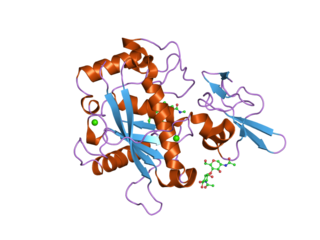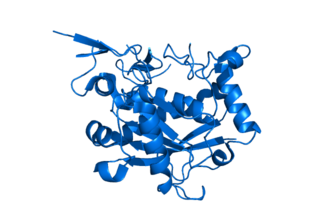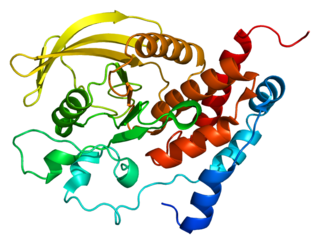Related Research Articles

A disintegrin and metalloproteinase with thrombospondin motifs 5 also known as ADAMTS5 is an enzyme that in humans is encoded by the ADAMTS5 gene.

A disintegrin and metalloproteinase with thrombospondin motifs 2 (ADAM-TS2) also known as procollagen I N-proteinase is an enzyme that in humans is encoded by the ADAMTS2 gene.

Aggrecan (ACAN), also known as cartilage-specific proteoglycan core protein (CSPCP) or chondroitin sulfate proteoglycan 1, is a protein that in humans is encoded by the ACAN gene. This gene is a member of the lectican (chondroitin sulfate proteoglycan) family. The encoded protein is an integral part of the extracellular matrix in cartilagenous tissue and it withstands compression in cartilage.

Mitogen-activated protein kinase 3, also known as p44MAPK and ERK1, is an enzyme that in humans is encoded by the MAPK3 gene.

A disintegrin and metalloproteinase with thrombospondin motifs 4 is an enzyme that in humans is encoded by the ADAMTS4 gene.

Suppressor of tumorigenicity 14 protein, also known as matriptase, is a protein that in humans is encoded by the ST14 gene. ST14 orthologs have been identified in most mammals for which complete genome data are available.

A disintegrin and metalloproteinase with thrombospondin motifs 1 is an enzyme that in humans is encoded by the ADAMTS1 gene.

Matrix metalloproteinase-19 (MMP-19) also known as matrix metalloproteinase RASI is an enzyme that in humans is encoded by the MMP19 gene.

Serine/threonine-protein kinase N2 is an enzyme that in humans and Strongylocentrotus purpuratus is encoded by the PKN2 gene.

Protein tyrosine phosphatase receptor-type R is an enzyme that in humans is encoded by the PTPRR gene.

Matrilin-3 is a protein that in humans is encoded by the MATN3 gene. It is linked to the development of many types of cartilage, and part of the Matrilin family, which includes Matrilin-1, Matrilin-2, Matrilin-3, and Matrilin-4, a family of filamentous-forming adapter oligomeric extracellular proteins that are linked to the formation of cartilage and bone, as well as maintaining homeostasis after development. It is considered an extracellular matrix protein that functions as an adapter protein where the Matrilin-3 subunit can form both homo-tetramers and hetero-oligomers with subunits from Matrilin-1 which is the cartilage matrix protein. This restricted tissue has been strongly expressed in growing skeletal tissue as well as cartilage and bone.

Matrix metalloproteinase-17 (MMP-17) also known as membrane-type matrix metalloproteinase 4 is an enzyme that in humans is encoded by the MMP17 gene.

A disintegrin and metalloproteinase with thrombospondin motifs 8 is an enzyme that in humans is encoded by the ADAMTS8 gene.

A disintegrin and metalloproteinase with thrombospondin motifs 9 is an enzyme that in humans is encoded by the ADAMTS9 gene.

A disintegrin and metalloproteinase with thrombospondin motifs 10 is an enzyme that in humans is encoded by the ADAMTS10 gene.

ADAMTS-like protein 1 is a protein that in humans is encoded by the ADAMTSL1 gene.

A disintegrin and metalloproteinase with thrombospondin motifs 3 is an enzyme that in humans is encoded by the ADAMTS3 gene. The protein encoded by this gene is the major procollagen II N-propeptidase.

Neutrophil collagenase, also known as matrix metalloproteinase-8 (MMP-8) or PMNL collagenase (MNL-CL), is a collagen cleaving enzyme which is present in the connective tissue of most mammals. In humans, the MMP-8 protein is encoded by the MMP8 gene. The gene is part of a cluster of MMP genes which localize to chromosome 11q22.3. Most MMP's are secreted as inactive proproteins which are activated when cleaved by extracellular proteinases. However, the enzyme encoded by this gene is stored in secondary granules within neutrophils and is activated by autolytic cleavage.

A disintegrin and metalloproteinase with thrombospondin motifs 12 is an enzyme that in humans is encoded by the ADAMTS12 gene.

Papilin is a protein that in humans is encoded by the PAPLN gene. Papilin is an extracellular matrix glycoprotein.
References
- ↑ Tortorella, MD; Burn, TC; Pratta, MA; Abbaszade, I; Hollis, JM; Liu, R; Rosenfeld, SA; Copeland, RA; et al. (1999). "Purification and cloning of aggrecanase-1: a member of the ADAMTS family of proteins". Science. 284 (5420): 1664–6. Bibcode:1999Sci...284.1664T. doi:10.1126/science.284.5420.1664. PMID 10356395.
- ↑ Abbaszade, I; Liu, RQ; Yang, F; Rosenfeld, SA; Ross, OH; Link, JR; Ellis, DM; Tortorella, MD; et al. (1999). "Cloning and characterization of ADAMTS11, an aggrecanase from the ADAMTS family". J Biol Chem. 274 (33): 23443–50. doi: 10.1074/jbc.274.33.23443 . PMID 10438522.
- ↑ Tortorella, M; Pratta, M; Liu, RQ; Abbaszade, I; Ross, H; Burn, T; Arner, E. (2000). "The thrombospondin motif of aggrecanase-1 (ADAMTS-4) is critical for aggrecan substrate recognition and cleavage". J Biol Chem. 275 (33): 25791–7. doi: 10.1074/jbc.M001065200 . PMID 10827174.
- ↑ Tortorella, MD; Liu, RQ; Burn, T; Newton, RC; Arner, E. (2002). "Characterization of human aggrecanase 2 (ADAM-TS5) substrate specificity studies and comparison with aggrecanase 1 (ADAM-TS4)". Matrix Biol. 21 (6): 499–511. doi:10.1016/S0945-053X(02)00069-0. PMID 12392761.